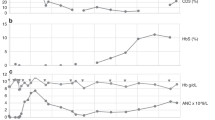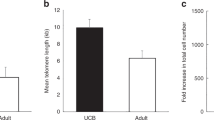Abstract
Patients requiring allogeneic stem cell transplantation who do not have an HLA-matched related donor can sometimes obtain an unrelated donor by searching volunteer registries. The majority of donors in the registries are Caucasoid, which results in a lower probability of a non-Caucasoid patient finding a suitable donor. Cord blood is increasingly used as a source of haematopoietic stem cells for allogeneic bone marrow reconstitution and so far the London Cord Blood Bank has banked almost 3000 cord blood units. An analysis of the first 1500 units banked showed that more than 30% of the London Cord Blood Bank units are derived from UK ethnic minorities compared with only 2% of individuals recruited locally for the British Bone Marrow Registry (BBMR). The HLA types found in these cord blood units reflect their ethnic diversity and include: HLA-A34, A36, A80, B75, B61, B53, B78, B81 and B82. The units stored by the London Cord Blood Bank show an HLA profile which differs considerably from that of locally typed adult volunteers for the BBMR panel and this should help to increase the chances of obtaining acceptably HLA-matched donors for patients from ethnic minorities. Bone Marrow Transplantation (2000) 25, 475–481.
This is a preview of subscription content, access via your institution
Access options
Subscribe to this journal
Receive 12 print issues and online access
$259.00 per year
only $21.58 per issue
Buy this article
- Purchase on Springer Link
- Instant access to full article PDF
Prices may be subject to local taxes which are calculated during checkout
Similar content being viewed by others
References
Sonnenberg FA, Eckman MH, Pauker SG . Bone marrow donor registries: the relation between registry size and probability of finding complete and partial matches Blood 1989 74: 2569–2578
Beatty PG, Mori M, Milford E . Impact of racial genetic polymorphism on the probability of finding an HLA-matched donor Transplantation 1995 60: 778–783
Cox ST, Marsh SGE, Scott I et al. HLA-A, -B, -C polymorphism in a UK Ashkenazi Jewish potential bone marrow donor population Tiss Antigen 1999 53: 41–50
Rubenstein P, Carrier C, Scaradavou A et al. Outcomes among 562 recipients of placental–blood transplants from unrelated donors New Engl J Med 1998 339: 1565–1577
Armitage S, Warwick R, Fehily D et al. Cord Blood Banking in London, the first 1000 collections Bone Marrow Transplant 1999 24: 139–145
Hurley CK, Wade JA, Oudshoorn M et al. A special report: histocompatibility testing guidelines for hematopoietic stem cell transplantation using volunteer donors Hum Immunol 1999 60: 347–360
Bunce M, O'Neill CM, Barnardo MCNM et al. Phototyping: comprehensive DNA typing for HLA-A, B, C, DRB1, DRB3, DRB4, DRB5, and DQB1 by PCR with 144 primer mixes utilising sequence-specific primers (PCR-SSP) Tiss Antigen 1995 46: 355–367
Bodmer JG, Marsh SGE, Albert ED et al. Nomenclature for factors of the HLA system, 1996 Tiss Antigen 1997 49: 297–321
Oh SH, Fleischauer K, Yang SY . Isoelectric focusing subtypes of HLA-A can be defined by oligonucleotide typing TissAntigen 1993 41: 135–142
Cavalli-Sforza LL, Bodmer WF . The Genetics of Human Populations Freeman: San Francisco 1971
Schipper RF, Schreuder GMT, D'Amaro J et al. HLA gene and haplotype frequencies in Dutch blood donors Tiss Antigen 1996 48: 562–574
du Toit ED, Taljaard DG, Marshall J et al. The HLA genetic constitution of the Bushmen (San) Hum Immunol 1990 28: 406–415
Hurley CK, Schreuder GMT, Marsh SGE et al. The search for HLA-matched donors: a summary of HLA-A*, -B*,-DRB1/3/4/5* alleles and their associations with serologically defined HLA-A, -B, -DR antigens Tiss Antigen 1997 50: 401–418
Dorak MT, Lawson TM, Parsons A et al. A deficit of homozygosity for HLA-DRB4*01 in Welsh new-born boys EurJ Immunogenet 1998 25: 54 (Abstr.2.9)
Darke C, Guttridge MG, Thompson J et al. HLA class I (AB) and II (DR,DQ) gene and haplotype frequencies in blood donors from Wales Exp Clin Immunogenet 1998 15: 69–83
Schipper RF, D'Amaro J, Bakker JT et al. HLA gene and haplotype frequencies in bone marrow donors worldwide registries Hum Immunol 1997 52: 54–71
Rea IM, Middleton D . Is the phenotypic combination A1B8Cw7DR3 a marker for male longevity? J Am Geriatric Soc 1994 42: 978–983
Acknowledgements
We would like to thank Carol Persaud and the collection staff of the London Cord Blood Bank for ethnic information and the staff of the Department of Histocompatibility and Immunogenetics, North London Blood Centre for sample processing and HLA typing.
Author information
Authors and Affiliations
Rights and permissions
About this article
Cite this article
Brown, J., Poles, A., Brown, C. et al. HLA-A, -B and -DR antigen frequencies of the London Cord Blood Bank units differ from those found in established bone marrow donor registries. Bone Marrow Transplant 25, 475–481 (2000). https://doi.org/10.1038/sj.bmt.1702197
Received:
Accepted:
Published:
Issue Date:
DOI: https://doi.org/10.1038/sj.bmt.1702197
Keywords
This article is cited by
-
Cord blood banking – bio-objects on the borderlands between community and immunity
Life Sciences, Society and Policy (2015)
-
Therapeutic targeting of naturally presented myeloperoxidase-derived HLA peptide ligands on myeloid leukemia cells by TCR-transgenic T cells
Leukemia (2014)
-
Age-dependent HLA profiles of the Israeli population: impact on hematopoietic cell donor recruitment and availability
Immunogenetics (2014)
-
Cord blood banks collect units with different HLA alleles and haplotypes to volunteer donor banks: a comparative report from Swiss Blood stem cells
Bone Marrow Transplantation (2009)
-
Results of an unrelated transplant search strategy using partially HLA-mismatched cord blood as an immediate alternative to HLA-matched bone marrow
Bone Marrow Transplantation (2004)



